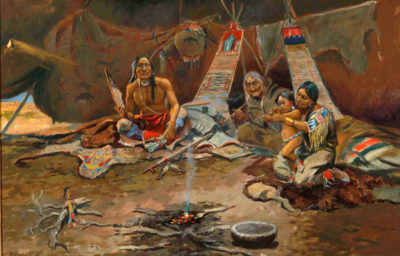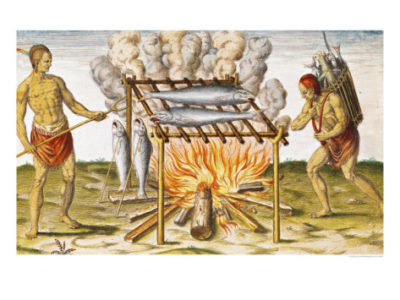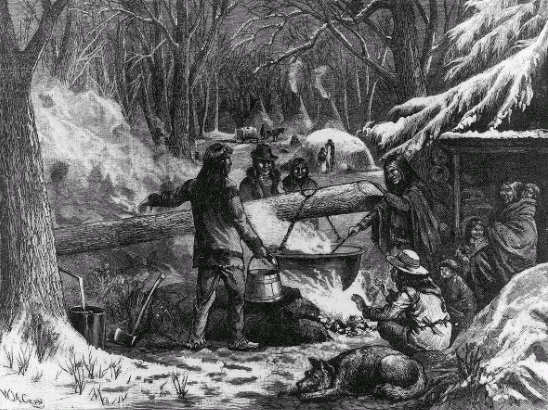If you are anything like me, then you are fascinated with how native people lived before the Europeans came to the “new world.” I find immense satisfaction in doing things on my own, without the benefit of modern technology.
I’m not knocking modern life. It certainly has its appeal! I’ve washed clothes by hand (exhausting), skinned animals and tanned hides (also exhausting), and made huge batches of soap with animal fat and wood ashes (more complicated than it sounds). One thing that has always perplexed me, however, is exactly how did the native people of this land make fire and cook without metal or matches?
In this article, we are going to take a look at how they did it and how you can, too, if the need should ever arise.
Making Fire the Old-Fashioned Way
Perhaps the first thing that comes to your mind is Tom Hanks in the movie Castaway, right? I can relate! When I first tried to rub two sticks together to make a fire, I had huge blisters and no fire. Thank goodness I had brought some matches with me!
So did the native people actually rub two sticks together? You bet they did! This is an old tried-and-true method that really does work, and isn’t that hard, if you have a little practice beforehand. In the same manner that Tom Hanks used, they would find one stick about 12 or 18 inches in length and break off the end, at about a 45-degree angle. Now, taking another stick only a few inches in length and placing it on the ground, they would make a small indentation, using a bone or rock most likely, and put the pointed end of the longer stick into the indentation of the small stick. The longer stick was placed between the palms and whirled back and forth, creating friction. The wood dust created by the friction would start to smoke. A piece of dry, light stuff was applied and then blown on to create fire.
This Cool-To-The-Touch Lantern Provides 100,000 Hours Of Emergency Backup Lighting [2]
This method must have caused plenty of blisters, however, so it was also very common among nomadic tribes to carry hot coals in the hollowed-out horn of a buffalo or moose antler to carry to the next campsite. Fires could then be started again from the hot coal.
Other tribes discovered that by striking two types of stones together, such as pyrites or chert, they would produce sparks. These sparks could ignite dry, light material fairly quickly. Later, Europeans brought flint and steel, which often was carried by native American people, but before that, it was usually stones made of pyrite and/or flint.
 [3]To avoid blisters, other tribes invented what is typically called a bowdrill. This uses a bow, very much like the kind used for hunting, with the exception being that the sinew was loose. In the same manner as mentioned above, the person would put one stick on top of another stick, but rather than use your hands to manipulate the vertical stick, the “string” of the bow was wrapped around it. One hand is placed on top of the vertical stick, while the other hand pulls the bow back and forth. This creates a great deal of heat and friction and has been known to start a fire in less than two minutes.
[3]To avoid blisters, other tribes invented what is typically called a bowdrill. This uses a bow, very much like the kind used for hunting, with the exception being that the sinew was loose. In the same manner as mentioned above, the person would put one stick on top of another stick, but rather than use your hands to manipulate the vertical stick, the “string” of the bow was wrapped around it. One hand is placed on top of the vertical stick, while the other hand pulls the bow back and forth. This creates a great deal of heat and friction and has been known to start a fire in less than two minutes.
If making fire by any of these methods interests you, then I would suggest that you practice beforehand. I made the assumption it would be fairly easy, and it is — but only after a few hours of practice.
No Pot? No Problem!
Well, at least for the native people it was not a problem to cook without metal pots or pans! For modern man, not as easy.
Depending on which tribe we are talking about, there were more ways to cook food than you can shake a stick at — with sticks being the most obvious choice. This is perhaps the easiest and least labor-intensive method that every camper learns pretty quickly. Put your meat on a stick and put it over the fire. However, there were plenty of other ways to cook food sans the ever-ready stick.
Ash cooking is still used in many places, even today. Fish, frog legs, even potatoes, can be wrapped in leaves and placed near or under hot ashes and coals. This is quick and effective, even if it means you might get a bit of ash on your food. Ashes actually don’t taste too bad!
Cooking in pits also was another popular method, especially if you wanted to cook a great deal of food at one time. Pits were dug into the earth, and then lined with an animal hide, fur removed, inside of the hide facing up. The food was placed in the hide, then covered with another hide or leaves. Hot coals were put inside the hole, and then covered again, usually with twigs and leaves.
Get The Essential Secrets Of The Top Survivalists In The World! [4]
 [5]Native people were well-known for their soups. How did they manage this without a metal pot? Similar to the pit method, a hole was dug in the ground and a piece of hide was used to line the hole. Water and food was put into the pit, where a fire was going nearby. Clean rocks were heated in the fire, and then dropped into the water. You would be surprised how quickly the water will reach a boil in this manner!
[5]Native people were well-known for their soups. How did they manage this without a metal pot? Similar to the pit method, a hole was dug in the ground and a piece of hide was used to line the hole. Water and food was put into the pit, where a fire was going nearby. Clean rocks were heated in the fire, and then dropped into the water. You would be surprised how quickly the water will reach a boil in this manner!
Tribes that lived near the sea were known to use large conch shells as pots to cook food. Southern tribes, such as the Navajo and Hopi, used clay pots, while others simply put flat rocks right next to a fire and let the food cook directly on the rock.
Last, but certainly not least, is a trick my father taught me. Small game that weighs about 2 pounds (1 kilo) or less can be easily roasted using a leather thong. My father would take the leather lace out of his boots, dunk them in water, and then tie one end of each lace to the meat. He would then make a stake out of a branch that made a “Y.” Putting one stake on each side of the fire, he would tie a lace to one of the stakes, and with the other lace, he would tie it to another small stick, with the stake being used as a support. The loose stick was then twisted around and around, so that the meat was on a manual type of rotisserie. He told me that his father taught him this skill and I must admit that it was pretty spectacular! Our meat was always perfectly done on all sides!
Try some of the above cooking methods on your next camping trip! You just might surprise yourself at all the ways you can make a fire and cook without modern utensils.
What fire-making or cooking tips would you add? Share your advice in the section below:
Learn How To ‘Live Off The Land’ With Just Your Gun. Read More Here. [6]
